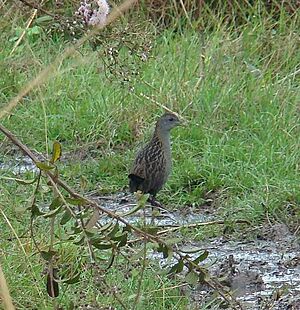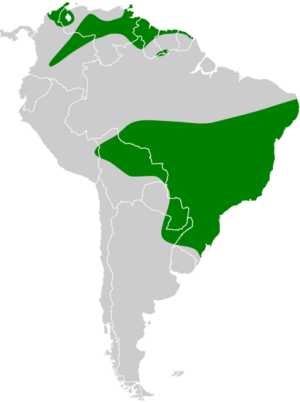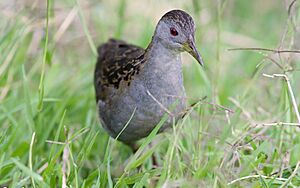Ash-throated crake facts for kids
Quick facts for kids Ash-throated crake |
|
|---|---|
 |
|
| Birigüi, São Paulo, Brazil. | |
| Conservation status | |
| Scientific classification | |
| Genus: |
Mustelirallus
|
| Species: |
albicollis
|
 |
|
| Synonyms | |
|
Porzana albicollis |
|
The ash-throated crake is a small bird from the rail and crake family. Its scientific name is Mustelirallus albicollis. You can find this bird in almost every country in mainland South America, except for Chile.
Contents
About This Bird
Sometimes, scientists change how they group different animals. This helps them understand how species are related. For the ash-throated crake, some groups of scientists decided to move it to a new genus called Mustelirallus in 2015. Before that, it was in the Porzana genus.
There are two main types, or subspecies, of the ash-throated crake. They are called M. a. albicollis and M. a. typhoeca.
What It Looks Like
The ash-throated crake is about 21 to 24 centimeters (8 to 9 inches) long. It weighs between 90 and 120 grams (3 to 4 ounces). Both male and female birds look the same.
Adult birds have black feathers on their upper body. These feathers have brown edges. Their throat, chest, and belly are a pale gray color. The sides of their body and the feathers under their tail have black and white stripes. They have a short, greenish beak and purplish-brown legs.
The subspecies M. a. typhoeca is a bit smaller and lighter in color than the other type.
Where It Lives
The two types of ash-throated crakes live in different areas. The M. a. typhoeca subspecies lives more to the north. You can find it in Colombia, Venezuela, northern Brazil, and the Guianas. It also lives in far northeastern Ecuador. This bird used to live on Trinidad but is no longer found there.
The M. a. albicollis subspecies lives in eastern and southern Brazil. It is also found in southeastern Peru, northern and eastern Bolivia, eastern Paraguay, and northern parts of Argentina and Uruguay.
These birds like to live in wet places. This includes freshwater marshes, swamps, and even rice fields. They can also be found in savannas and pastures. They usually prefer the drier parts of these wet areas. You can find them from sea level up to about 1,200 meters (3,900 feet) high.
How It Behaves
Moving Around
Most people think ash-throated crakes stay in one place. However, some have been seen moving around at different times of the year in Colombia.
What It Eats
The ash-throated crake usually looks for food hidden in plants. Sometimes, it comes out to the edges of the plants. It eats grass seeds. It also eats adult insects and their young, like moths, ants, and beetles.
Making a Family
Scientists are still learning about when ash-throated crakes have their young. They might nest at any time of the year. The nest is a big, open bowl made from dry grass. It is built on the ground or just above it. Often, the nest is hidden among tree roots or in tall grass.
A female crake usually lays two or three eggs. Sometimes, she can lay as many as six eggs. We don't know much else about how these birds raise their young.
Its Calls
The ash-throated crake has a special song. It sounds like a loud, fast series of vibrating notes, almost like a "machine-gun 'd'd'd'd'd'-ou'." It also makes a sharp "tuk" sound. These birds usually sing and call in the early morning and evening.
Its Status
The IUCN (International Union for Conservation of Nature) says the ash-throated crake is a "Least Concern" species. This means it is not currently in danger of disappearing. It lives across a very large area. However, we don't know exactly how many of these birds there are or if their numbers are changing.
It is hard to find and watch these birds because they are shy and like to be alone. This makes it difficult to know their exact numbers and where they live.



